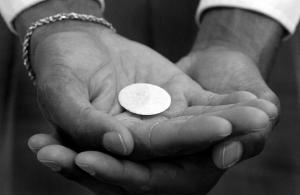Issue Date: April 25, 2003
By JOHN L. ALLEN JR. Aiming to rekindle Catholic “amazement” over the Eucharist, as well as to “banish dark clouds of unacceptable doctrine and practice,” John Paul II on Holy Thursday devoted the 14th encyclical of his pontificate to the Eucharist and its relationship to the church. “Eucharist,” from a Greek word meaning “giving thanks,” is the term Catholics use to refer to the transformation of bread and wine into the body and blood of Jesus Christ in the Mass. The 78-page document, brief by the standard of papal encyclicals, is titled Ecclesia De Eucharistia. It presents a mix of autobiographical reflection, spiritual meditation, and warnings about abuses. The pope wistfully recalls celebrating Mass at various points in his life, from his first pastoral assignment at Niegowic, Poland, to “chapels built along mountain paths, on lakesides and seacoasts … on altars built in stadiums and city squares.” “It’s an old man passing on his heritage to the church,” said Blessed Sacrament Fr. Anthony McSweeney, theologian and director of Rome’s Center Eucharistia. John Paul endorses the liturgical reforms that followed the Second Vatican Council (1962-65), saying they contributed to a “more conscious, active and fruitful participation” in the Mass. Yet he also cites “shadows” in current eucharistic practice. Among the abuses, he lists:
Jesuit Fr. Keith Pecklers, a liturgical expert who teaches at Rome’s Gregorian University as well as the Pontifical Liturgical Institute, applauded the encyclical’s emphasis that the Mass is both a “cosmic” event as well as a summons to social responsibility here on earth. The document’s most original contribution may come in the final chapter, where John Paul links Mary with the Eucharist. He suggests that when Mary bore Jesus in her womb, she “became in some way a tabernacle, the first tabernacle in history.” Ironically, the restrictive language on intercommunion comes as three European ecumenical institutes -- one of them Catholic -- issued a joint statement saying that no sufficient theological reasons remain to block eucharistic hospitality between Protestants and Catholics. “Even though there are still differences on the question of ministry, a convergence has been reached on basic principles which makes eucharistic hospitality possible,” the institutes said this month. The institutes are the Catholic Institute for Ecumenical Research in Tübingen, Germany, the (Protestant) Institute for Inter-Confessional Research in Bensheim, Germany, and the Institute for Ecumenical Research in Strasbourg, France, founded by the Lutheran World Federation. McSweeney notes two senses in which the encyclical actually strikes ecumenically positive notes. First, John Paul insists there is only one sacrifice of Christ on the cross, and that the Mass does not “add” to it. This addresses a Reformation-era accusation that the Catholic church, in the Mass, claims to “complete” Christ’s sacrifice on Calvary. Second, the pope appeals to Eastern Christian sensibilities by emphasizing the role of the Holy Spirit in the Eucharist. McSweeney noted that of the eight ancient Christian writers quoted by John Paul, six are Eastern. On other points, the pope seeks to connect the sacraments of penance and the Eucharist, stressing that serious sins must be confessed before Communion. When the sin is public knowledge, the pope says, the church may be compelled to withhold the Eucharist until penance is done. Finally, John Paul appeals to priests to follow the liturgical rules. “Liturgy is never anyone’s private property, be it of the celebrant or of the community in which the mysteries are celebrated,” he writes. The pope notes that the Vatican is currently preparing a disciplinary document to address abuses to the Eucharist. Sources tell NCR the Congregation for Divine Worship has primary responsibility for the document, expected to appear in the fall. A theologian called the concluding reflection on Mary innovative. “It is an original, beautiful meditation on a theme very little developed in the theological literature,” said Fr. Antonio Miralles, who teaches sacramental theology at Santa Croce University, and who serves as a consultor to both the Congregation for the Doctrine of the Faith and the Congregation for Clergy. “Chapters 3 and 4, concerning the apostolicity of the Eucharist and Communion, will be closely read by theologians, but they restate in an organic way points already made by the magisterium,” Miralles said. Another expert, however, felt the Marian excursus may be problematic ecumenically. “I wonder if non-Catholics will have difficulty grasping the link between Marian devotion and eucharistic practice,” Pecklers said. The April 17 release in Rome of Ecclesia De Eucharistia had an unusual multi-media dimension. From 8 p.m. to 1 a.m. on the evening of Holy Thursday, the façade of one of the buildings housing the Roman curia was illuminated by a giant projection of a painting titled “The Last Supper” by Russian Orthodox artist Natalia Tsarkova, the official portrait-maker of John Paul II. Tsarkova’s painting departs from classic images of the Last Supper by showing Jesus facing the world, and places a woman among those present. The projection was timed to coincide with the encyclical, since Catholics believe it was at the Last Supper that Jesus instituted the Eucharist. A news release noted that John Paul would be able to see the massive image from the window of his apartments. Related Web site Text of Ecclesia De Eucharistia John L. Allen Jr. is NCR Rome correspondent. His e-mail address is jallen@natcath.org National Catholic Reporter, April 25, 2003 |
